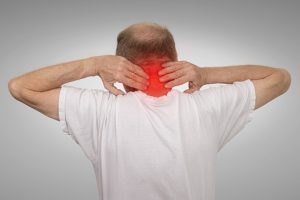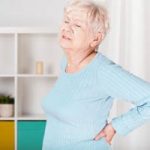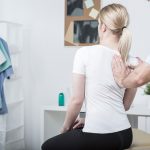 Spinal stenosis is a spinal condition characterized by the narrowing of the open spaces within the spine. This narrowing causes pressure on the spinal cord and nerves, which can travel to the arms and legs. Spinal stenosis is most common in the lower back and the neck.
Spinal stenosis is a spinal condition characterized by the narrowing of the open spaces within the spine. This narrowing causes pressure on the spinal cord and nerves, which can travel to the arms and legs. Spinal stenosis is most common in the lower back and the neck.
It can often be symptomless, but for many people, symptoms may vary from pain and tingling to even problems with the bowel and bladder. We will explain the signs and symptoms of spinal stenosis in more detail later on.
Advertisement
Spinal stenosis is most often caused by wear and tear, as well as changes in the spine from osteoarthritis, but there are many other causes that can contribute to this ailment as well.
Types of Spinal Stenosis
Where spinal stenosis occurs along the spine and the cause of it determines the type of spinal stenosis a person has. There are two main types of spinal stenosis: cervical occurs in the neck and lumbar occurs in the lower back.
Within these two types, there are subtypes. Foraminal stenosis occurs when nerves exiting the spinal column through the neuroforamen become compressed. Central canal stenosis is a result of compressed nerves in the spinal canal.
Some patients may have cervical and lumbar spinal stenosis at the same time.
Spinal Stenosis Causes
Spinal stenosis can be caused by wear and tear and changes in the spine as a result of osteoarthritis, but other causes of spinal stenosis include:
Aging – the risk of spinal stenosis increases with age
Arthritis – osteoarthritis and rheumatoid arthritis
Heredity – a small spinal canal at birth can cause spinal stenosis in younger individuals
Instability of the spine – vertebras slipping forward, narrowing the spinal canal
Tumors – tumors located on the spine can lead to a narrowing of the spine. Spinal tumors can also affect bone resorption – a process needed to make bones stronger.
Trauma – accidents and injuries to the spine can cause the spinal canal to narrow, contributing to spinal stenosis.
Spinal stenosis symptoms, risk factors, and complications
 Spinal stenosis may not present any symptoms, meaning it can go undetected for quite some time. When symptoms do appear, they may start off dull and progress gradually. Some signs and symptoms to pay attention to include back and neck pain, numbness, weakness, cramping or pain in the arms or legs, pain spreading down the leg, and foot problems.
Spinal stenosis may not present any symptoms, meaning it can go undetected for quite some time. When symptoms do appear, they may start off dull and progress gradually. Some signs and symptoms to pay attention to include back and neck pain, numbness, weakness, cramping or pain in the arms or legs, pain spreading down the leg, and foot problems.
Depending on the severity of spinal stenosis, other symptoms may present themselves such as loss of control of your bladder or bowels, difficulty having sex, as well as loss of feeling or weakness in the arms and legs.
Generally, patients with spinal stenosis are over the age of 50. If spinal stenosis is diagnosed in younger individuals, it is often a result of inborn smaller spinal canal.
Complications of spinal stenosis include numbness, weakness, balance problems, incontinence – loss of bladder control, weak bladder – and paralysis.
How is Spinal Stenosis Diagnosed?
After reviewing your medical history and symptoms, your doctor can run a slew of different tests to properly diagnose spinal stenosis. This includes an x-ray that can reveal changes to the bones; MRI, which can reveal a cross-sectional image of the spine without exposing patients to radiation along with revealing the nerves and any possible compression of them; and a CT or CT myelogram which combines x-ray images taken at different angles to reveal a cross-sectional look at the spine.
Spinal Stenosis Natural Treatment and Alternative Therapies
Treatment for spinal stenosis may be medical or alternative, depending on the severity of the condition. Some common remedies that your doctor may prescribe include nonsteroidal anti-inflammatory drugs and other pain relievers, corticosteroid injections, anesthetic injections, restriction of activity, exercises and physical therapy, a lumbar brace, and back support.
Some alternative therapies include chiropractic treatment and acupuncture. Chiropractors may manipulate the spine to create greater space between the vertebrae and reduce pressure on nerves. Acupuncture is an ancient Chinese technique that involves inserting needles into specific points of the body. Acupuncture has been shown in numerous studies to be beneficial to those with back pain.
Surgery may be a treatment option for spinal stenosis as a way to relieve pressure on the spinal cord and nerves. Surgery can also help restore and maintain spine alignment, which is done by trimming, removing, and adjusting the affected parts of the spine.
Surgery, although beneficial, always involves a risk. Consulting with your doctor to determine if you’re a good candidate for surgery and discussing your risks prior to the procedure is a good idea to minimize complications.
Spinal stenosis exercises
 As mentioned, exercise and physical therapy can be beneficial for spinal stenosis, but not all exercises are ideal. In the beginning, you may want to consult with a physical therapist to determine which exercises are safe and receive a proper demonstration of how they should be performed to reduce your risk of injury. Exercise should only be completed as tolerated. You should not push yourself if it doesn’t feel right, as that could worsen the condition.
As mentioned, exercise and physical therapy can be beneficial for spinal stenosis, but not all exercises are ideal. In the beginning, you may want to consult with a physical therapist to determine which exercises are safe and receive a proper demonstration of how they should be performed to reduce your risk of injury. Exercise should only be completed as tolerated. You should not push yourself if it doesn’t feel right, as that could worsen the condition.
Advertisement
Some beneficial exercises include walking and swimming, as both exercises are low impact. Running is too vigorous for spinal stenosis as it adds pressure to the spine and thus can worsen the condition.
Always speak to your doctor prior to starting an exercise routine if you have spinal stenosis in order to prevent injury and complications related to the condition.
Also read:
- Sciatic Nerve Pain: Prevention, Stretches, and Exercises for Pain Relief
- Exercises and tips to improve posture and alleviate back pain
